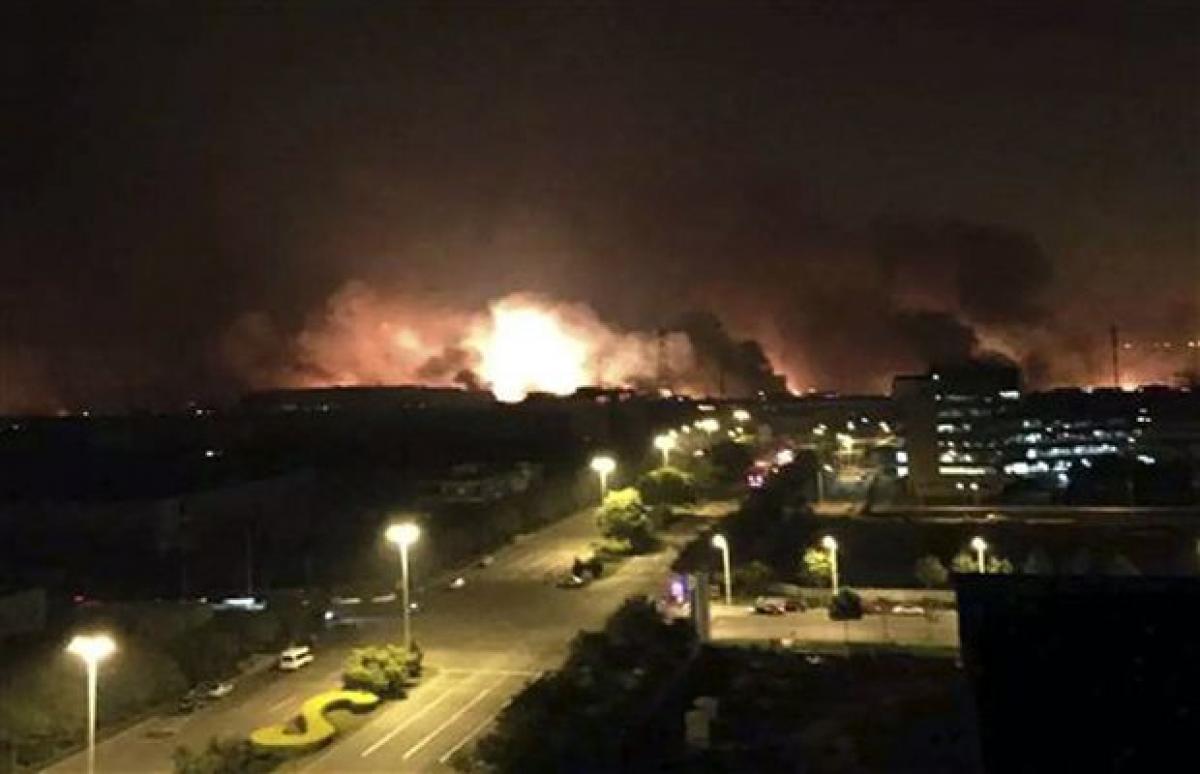Live
- Chandrababu Advocates Strict Measures for Social Welfare and Infrastructure Development in AP
- Show of brotherhood by Vijayan, Stalin at event to honour Dravidian icon
- District Collectors’ conference with CM begins
- Celebrations kick off in Saudi Arabia to welcome FIFA World Cup 2034
- Google Unveils Jules AI to Help Developers Fix Code Errors
- Bengaluru Techie’s Tragic Suicide Sparks Outrage Over Family Disputes and Legal Failures
- Crucial Union Cabinet meeting to discuss One Nation One Election
- Irrigation AE Nikhesh Kumar Arrested in Disproportionate Assets Case, Granted 4-Day Custody
- Your Daily Horoscope for December 12, 2024: Unlocking Mysteries of the Stars
- Hyderabad: 18-Month-Old Girl Dies After Being Hit by Car in Jawaharnagar
Just In

x
Highlights
Huge explosions at a warehouse for dangerous materials in the northeastern Chinese port of Tianjin killed at least 17 people, injured hundreds and sent massive fireballs into the night sky, officials and witnesses said Thursday.
Huge explosions at a warehouse for dangerous materials in the northeastern Chinese port of Tianjin killed at least 17 people, injured hundreds and sent massive fireballs into the night sky, officials and witnesses said Thursday.
.jpg)
China’s state broadcaster, CCTV, said that at least 17 people were killed and that 32 were in critical condition in hospital. Hundreds of others were taken to hospital. The explosions late Wednesday knocked off doors of buildings in the area and shattered windows up to several kilometers (miles) away.
“I thought it was an earthquake, so I rushed downstairs without my shoes on,” Tianjin resident Zhang Siyu, whose home is several kilometers from the blast site, said in a telephone interview. “Only once I was outside did I realize it was an explosion. There was the huge fireball in the sky with thick clouds. Everybody could see it.”
Zhang said she could see wounded people weeping. She said she did not see anyone who had been killed, but “I could feel death.”
Police in Tianjin said an initial blast took place at shipping containers in a warehouse for hazardous materials owned by Ruihai Logistics, a company that says it’s properly approved to handle hazardous materials. State media said senior management of the company had been detained by authorities.
It’s part of an industrial park, with some apartment buildings in the vicinity.
The official Xinhua News agency said an initial explosion triggered other blasts at nearby businesses. The National Earthquake Bureau reported two major blasts before midnight, the first with an equivalent of 3 tons of TNT, and the second with the equivalent of 21 tons.
Photos taken by bystanders and circulating on microblogs show a gigantic fireball high in the sky, with a mushroom-cloud. Other photos on state media outlets showed a sea of fire that painted the night sky bright orange, with tall plumes of smoke.
About 2 kilometers (1.2 miles) from the explosion site is the luxury Fifth Avenue apartment complex on a road strewn with broken glass and pieces of charred metal thrown from explosion. Like surrounding buildings, the Mediterranean style complex had all its windows blown out, and some of its surfaces were scorched.
“It’s lucky no one had moved in,” said a worker on the site, Liu Junwei, 29. “But for us it’s a total loss. Two years hard work down the drain.”
“It had been all quiet, then the sky just lit up brighter than day and it looked like a fireworks show,” said another worker on the site who gave just his surname, Li.
In one neighbourhood about 10 to 20 kilometres (6 to 12 miles) from the blast site, some residents were sleeping on the street wearing gas masks, although there was no perceptible problem with the air apart from massive clouds of smoke seen in the distance.
Security guards and a resident push what appears to be a lifeless body into a hospital in northeastern China’s Tianjin municipality
“It was like what we were told a nuclear bomb would be like,” said truck driver Zhao Zhencheng, who spent the night in the cab of his truck. “I’ve never even thought I’d see such a thing. It was terrifying but also beautiful.”
At the nearby Taida Hospital as dawn broke, military medical tents were set up. Photos circulating online showed patients in bandages and with cuts.
State broadcaster CCTV said six battalions of fire-fighters had brought the ensuing fire under control, although it was still burning in the early hours of Thursday.
Ruihai Logistics says on its website that it was established in 2011 and is an approved company for handling hazardous materials. It says it handles 1 million tons of cargo annually.
Tianjin, with a population of about 15 million, is about 120 kilometers (75 miles) east of Beijing on the Bohai Sea and is one of the country’s major ports. It is also one of China’s more modern cities and is connected to the capital by a high speed rail line.

Next Story
More Stories
ADVERTISEMENT
© 2024 Hyderabad Media House Limited/The Hans India. All rights reserved. Powered by hocalwire.com







